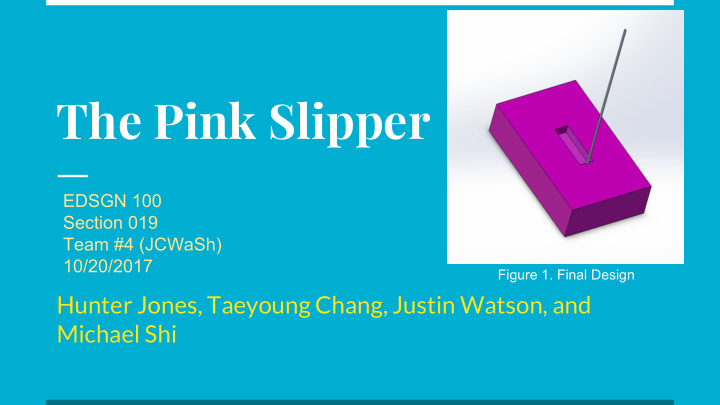



The Pink Slipper EDSGN 100 Section 019 Team #4 (JCWaSh) 10/20/2017 Figure 1. Final Design Hunter Jones, Taeyoung Chang, Justin Watson, and Michael Shi
Table of Contents - Mission Statement - Stakeholder Needs - Constraints and Requirements - Design Specs - Brainstorms - Calculations - Original Design / Test - Final Design / Test - Summary and Conclusions
Mission Statement Our mission statement is to make efficient use of our time and effort towards building a practical device that allows one to safely walk on water.
Problem/Objective Walking on water has been a desire for a plethora of humans for a very long.. The ability to walk on water should be something that everyone can accomplish in a safe and inexpensive manner. Our goal is to achieve this while making a functional and marketable product that turns profit.
Stakeholder needs Not all stakeholders could be evaluated for this project ● The stakeholders wanted something that was reasonable and affordable ● 18-25 year olds seemed most interested ● Safety is a big concern ● Needs a buoyant material that is comfortable but firm at same time ● Needs to be able to place one foot in front of the other continuously in water ● (by definition of walking) *Stakeholder data gathered from online surveys and in-person interviews
Constraints and requirements No use of batteries or liquid fuel ● It couldn’t touch the bottom or sides of the pool ● Materials within an $80 price range in order to make money on the suggested ● $120 retail from survey Be easy to operate and mount ● Material cannot break apart in the water ● Material restrictions placed by natatorium ●
Design Specs Set the price of materials at close to 50$ ● The target audience became 18-25 year olds ● Determined a “safe” weight range of 120-180 lbs ● Made mostly of polystyrene ●
Brainstorms Figure 4. Michael Idea Figure 2. Figure 3. Figure 5. Justin Idea Hunter Idea Nathan Idea
Decision Matrix Table 1. Decision Matrix
Calculations F=ma, a is gravity (9.8 m/s 2 ) ● Calculations for forces ○ Maximum Weight (180 lbs=81.65 kg), F=800.17 N ■ Minimum Weight (130 lbs=58.97 kg), F=577.91 N ■ Weight of 1 Shoe (37.61 kg), F=368.58 N ■ Weight of 2 Shoes and Maximum Weight (156.87 kg), F=1537.33 N ■ Weight of 2 Shoes and Minimum Weight (134.19 kg), F=1315.06 N ■ F B =P Water gV, V=lwh (P Water =1000 kg/m 3 , g=9.8 m/s 2 , l=0.6096 m, and w= ● 0.7620) Calculations for buoyant force for trial 1 ○ ■ F B =693.76 N 2 F B =1387.53 N ■ Calculations for buoyant force for trial 2 (h=0.1905 m) ○ F B =867.20 N ■ 2 F B =1734.41 N ■
Calculations Table 2. Table of Spreadsheet for Calculations Mass Force (N) Length Width Height Volume Buoyant Force Buoyant Force of 2 Gravity Density of Water (m 3 ) (m/s 2 ) (kg/m 3 ) (kg) (M) (m) (m) (N) Shoes (N) 81.65 800.17 0.6096 0.7620 0.1524 0.0708 693.76 1387.53 9.8 1000 58.97 577.91 0.6096 0.7620 0.1905 0.0885 867.20 1734.41 37.61 368.58 156.87 1537.33 134.19 1315.06
Systems and Subsystems The Shoes ● Flotation ○ Polystyrene ■ Balance ○ The string that attached the two shoes ■ The string that the user holds ■ The wide base of the shoe ■
Bill of Materials Approximate Total Cost: $63 All materials purchased at Home Depot Approximate Bill of Materials: 12ft $18.00 $9.00 10ftx6ftx1.5in $12.00 $24.00
Original Design Figure 5. Original Design
First Test
Final Design Drawing and Actual Prototype Figure 8. Final Design Drawing Figure 7. Prototype
Summary and Conclusions Fixed the issue of the shoes drifting apart by the final test ● Fixed the issue of balance from the front and back with potential of adding ● more support before production At the end of the process we have created: ● A prototype flotation device capable of handling a passenger ○ A prototype that can be handled by the target audience ○ A prototype that has the potential to “walk on water” ○ At the end of the process we learned: ● Balance is a very important component to maneuverability ○ The more prototypes and testing opportunities, the more functional design ○ The physical characteristics of the consumer are an integral part to the design ○
Gantt Chart Table 3. Gantt chart
References Adkins, J. I. “You'll Go Absolutely Bananas over Gorilla Glue.” Chicago Tribune, Chicago Tribune, 26 Sept. 2004, articles.chicagotribune.com/2004-09-26/news/0409250247_1_gorilla-glue-ace-hardware-home-depot. “What Is Polystyrene? | Uses, Benefits, and Safety Facts.” ChemicalSafetyFacts.org, ChemicalSafetyFacts, 22 Sept. 2017, www.chemicalsafetyfacts.org/polystyrene-post/.
Questions?
Recommend
More recommend